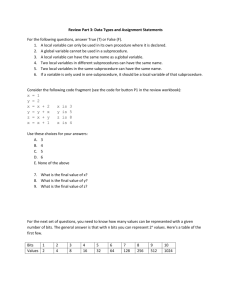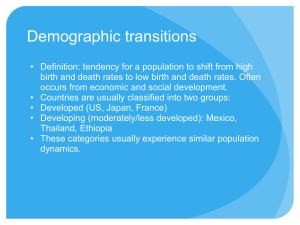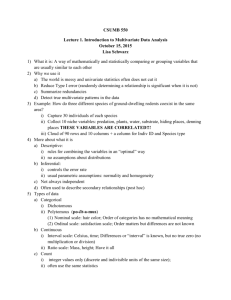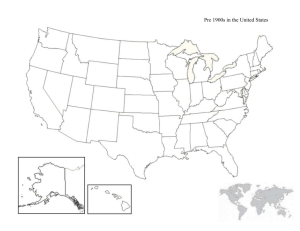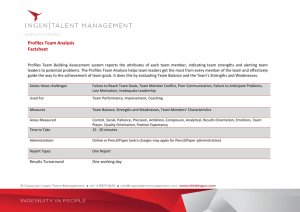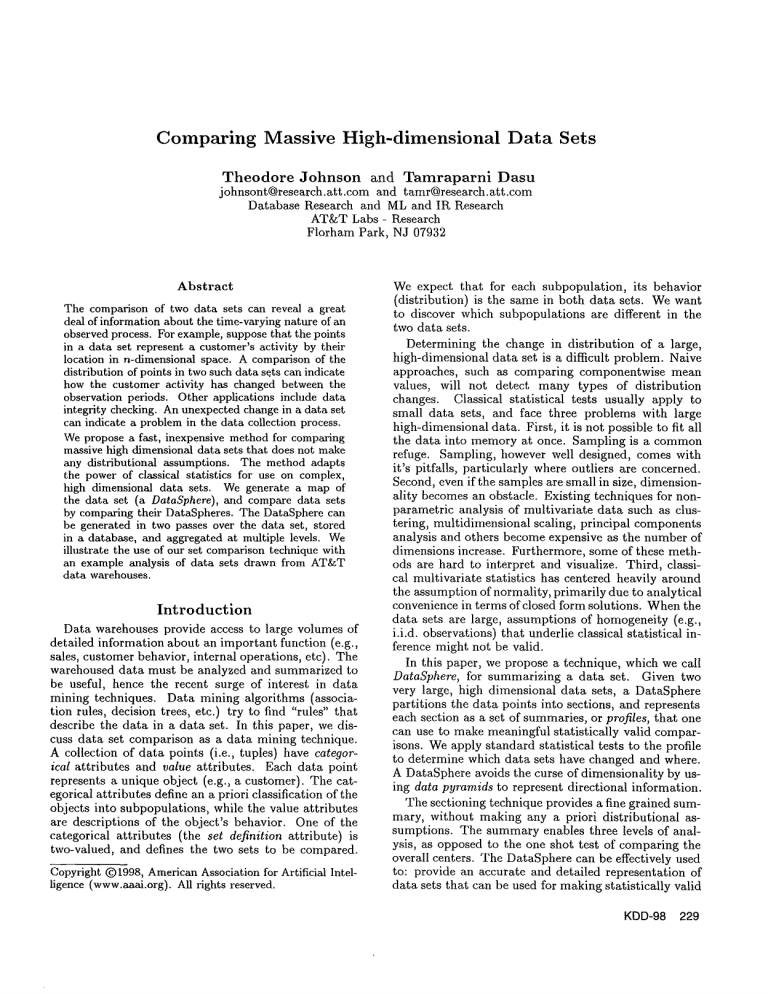
Comparing Massive High-dimensional
Data Sets
Theodore
Johnson
and Tamraparni
Dasu
johnsont@research.att.com and tatar@research.art.corn
Database Research and MLand IR Research
AT&TLabs - Research
Florham Park, NJ 07932
Abstract
The comparison of two data sets can reveal a great
deal of information about the time-varying nature of an
observed process. For example,suppose that the points
in a data set represent a customer’sactivity by their
location in n-dimensional space. A comparisonof the
distribution of points in twosuch data se.ts can indicate
howthe customer activity has changed between the
observation periods. Other applications include data
integrity checking. An unexpectedchange in a data set
can indicate a problemin the data collection process.
Wepropose a fast, inexpensive method for comparing
massive high dimensional data sets that does not make
any distributional assumptions. The method adapts
the powerof classical statistics for use on complex,
high dimensional data sets. Wegenerate a map of
the data set (a DataSphere), and compare data sets
by comparing their DataSpheres. The DataSphere can
be generated in two passes over the data set, stored
in a database, and aggregated at multiple levels. We
illustrate the use of our set comparisontechnique with
an example analysis of data sets drawn from ATg~T
data warehouses.
Introduction
Data warehouses provide access to large volumes of
detailed information about an important function (e.g.,
sales, customer behavior, internal operations, etc). The
warehoused data must be analyzed and summarized to
be useful, hence the recent surge of interest in data
mining techniques. Data mining algorithms (association rules, decision trees, etc.) try to find "rules" that
describe the data in a data set. In this paper, we discuss data set comparison as a data mining technique.
A collection of data points (i.e., tuples) have categorical attributes and value attributes.
Each data point
represents a unique object (e.g., a customer). The categorical attributes define an a priori classification of the
objects into subpopulations, while the value attributes
are descriptions of the object’s behavior. One of the
categorical attributes (the set definition attribute) is
two-valued, and defines the two sets to be compared.
CopyrightC)1998,AmericanAssociationfor Artificial Intelligence (www.aaai.org).All rights reserved.
We expect that for each subpopulation, its behavior
(distribution)
is the same in both data sets. Wewant
to discover which subpopulations are different in the
two data sets.
Determining the change in distribution of a large,
high-dimensional data set is a difficult problem. Naive
approaches, such as comparing componentwise mean
values, will not detect many types of distribution
changes. Classical statistical
tests usually apply to
small data sets, and face three problems with large
high-dimensionaldata. First, it is not possible to fit all
the data into memoryat once. Sampling is a common
refuge. Sampling, however well designed, comes with
it’s pitfalls, particularly where outliers are concerned.
Second, even if the samples are small in size, dimensionality becomesan obstacle. Existing techniques for nonparametric analysis of multivariate data such as clustering, multidimensional scaling, principal components
analysis and others become expensive as the number of
dimensions increase. Furthermore, some of these methods are hard to interpret and visualize. Third, classical multivariate statistics has centered heavily around
the assumption of normality, primarily due to analytical
convenience in terms of closed form solutions. Whenthe
data sets are large, assumptions of homogeneity (e.g.,
i.i.d, observations) that underlie classical statistical inference might not be valid.
In this paper, we propose a technique, which we call
DataSphere, for summarizing a data set. Given two
very large, high dimensional data sets, a DataSphere
partitions the data points into sections, and represents
each section as a set of summaries, or profiles, that one
can use to make meaningful statistically
valid comparisons. Weapply standard statistical tests to the profile
to determine which data sets have changed and where.
A DataSphere avoids the curse of dimensionality by using data pyramids to represent directional information.
The sectioning technique provides a fine grained summary, without making any a priori distributional
assumptions. The summaryenables three levels of analysis, as opposed to the one shot test of comparing the
overall centers. The DataSphere can be effectively used
to: provide an accurate and detailed representation of
data sets that can be used for makingstatistically valid
KDD-98 229
comparisons of centers, distribution in space and interactions amongvariables; isolate interesting subpopulations; and identify interesting variables
Our algorithms (discussed in the appendix) require
only two passes over the the data set. The profiles are
small, so data set comparisonusing the profiles is very
fast. The profiles we use are summable. Hence, the
profiles can be treated as associative aggregates and
managed as a data cube (Gray et al. 1996). A single
profile collection permits set comparisons at different
levels of aggregation. In addition, the data in the profiles permits a deeper analysis of the trends that cause
the subpopulations to diverge.
The DataSphere enables fast comparison of data sets.
For instance, given two or more data sets, how can we
establish in a quick inexpensive fashion whether they
are produced by the same statistical
process? The
question arises often in several contexts. For exanaple, comparing customer behavior by region, by group,
by month; comparing the output of automated data
collecting devices to establish uniformity; Another important application lies in detecting inconsistencies between data sets. An automated fast screening of data
sets for obvious data integrity issues could save valuable
analysis time.
In order to answer the above questions, we need to
define a metric for similarity of two or more data sets.
Ideally, we should be testing the hypothesis that the
joint distribution of the variables is the same in the two
data sets. However, we address the problem by testing
a set of weakerhypotheses that covers different aspects
of the distribution, using just the profile information.
In this paper, similarity is tested in a two step fashion.
First, we test the proportion of points in each of the sections within each subpopulation, using a multinomial
test. The test would establish whether the points are
distributed in a similar fashion amongthe sections for
the two data sets. Second, we compare the multivariate
means of the points that fall in the sections using the
Mahalanobis D2 test. In addition, we could use tests
for each variable individually to see which variable is
driving the difference.
Problem Definition
Westart with somedefinitions. A data set is a collection
of tuples D = {tl, t2,..., tn}. Eachtuple ti is composed
oft = v+c+l attributes.
Of the r attributes,
v are
value attributes, c are categorical attributes, and one
of the attributes is the set definition attribute. The
categorical attributes define subpopulations of D that
will be compared to each other. The value attributes
take real values and embedthe tuple in a v-dimensional
space. The set definition attribute takes its value from
the set {1,2}. Let Si be the set of tuples in D such
that the set definition attribute has value i. Let C
be a particular value of the categorical variables that
exists in D. Then we define subpopulation D[Ci] to be
the tuples in D that have value C in their categorical
variables and value i in their set definition attribute,
230 Johnson
i G {1, 2}. Finally we define V[(7~] to be the projection
of D[Ci] to the value attributes.
The problem we address is, for each value of C’ that
occurs in D, is the distribution of V[C1] significantly
different than the distribution of V[C2]. In particular,
we are interested in answering the following questions.
1. Which subpopulations have changed their
in 5’2 as comparedto Sa.
behavior
2. Of the subpopulations which changed their behavior,
which sections show the most change?
3. Of the subpopulations which changed their behavior,
which variables exhibit the most change?
Data Sectioning
In a previous work, we describe the use of data seetioning for exploratory data analysis (Dasu 8z Johnson
1997). In this section, we describe briefly the method
that produces the profiles used for data set comparison. The DataSphere reduces a large data set D to a
smaller and more manageable representation that, ideally, is easy to compute;is easy to interpret; is amenable
to further analysis; and requires no prior assumptions.
The method we propose partitions a data set D into
k layers {Diff=l. Each layer represents a subset of V
that is more homogeneousthan the entire data set. We
have found that a good method for sectioning data into
layers is to use the distance of the points from a center
of the data cloud. Data points within the same distance range [dl,di+l] frolll the center c, belong to the
same layer. Here the index i refers to the layer number,
and di represents the distance cut off between layers.
The partitioning implies that we get to the "typical"
data (closest to the center) first and expand outwards
to more atypical points. Wecompute the cutoff points
d i using a fast quantiling algorithm, so each layer contains the same number of data points.
Directional information is incorporated using the
concept of pyramids (Berchtold, Bohm, &: Kriegel
1998). Briefly, a d dimensional set can be partitioned
into 2d pyramids Pi:k, i = 1 .... , d whose tops meet at
the center of the data cloud. If xl, x2,..., Xdrepresents
a data point p and if Yl, Y~., ¯ ¯., Vd is the corresponding
normalized vector, then
PEPi+ iflwI>Ivjl,
w>Oj=l,...,dj¢i
P~P~- iflY~l>lv~l,w<O j=l,...,dj¢i
We define a section, $(Di,Pi+,C) to be the tuples with categorical attributes C such that the value
attributes
lie in layer Di, pyramid Pt’+.
Each
section 8(Di,Pi+,C) is summarized using a profile
7)(Di, Pi:k, C). In Figure 1, we show a two dimensional
illustration of sectioning with data pyramids. The dotted diagonal lines represent the pyramid boundaries.
The black and white dots might correspond to two different subpopulations such as male and female.
section4
o
Pyramid
Y+
@
o
ramid
,x.r
X+
¯
@@
Pyramid Y-
Figure 1: Data Sectioning with Pyramids.
Profile
A profile ?~(Di, Pi+, C) is a set of statistics, both scalars
and vectors, that summarizes the data points in a section. In order to be a memberof the profile, a statistic
should be easy to compute, be easy to combine across
sections, and have the same interpretation
when combined across sections or data sets.
These properties ensure that we can compute the
summaries in only two passes over the data set. For
the purposes of data set comparison, the statistics in
the profile are the count of the data points, the vector
of means (of the value attributes), and the covariance
matrix. Including the count ensures that the mean vector and the covariance matrix are summable. A similar
approach is taken in the BIRCHclustering algorithm
(Zhang, Ramakrishnan, & Livny 1996), which use profiles to represent clusters in a way that allows them to
be combined easily.
A collection of profiles is a data mapof a data set.
The data maphas several nice properties. It is compact,
transparent, and easy to understand representation of
the data set, enabling a visualization of the overall data
set. Each profile represents a small homogeneousdata
space, makingprofile analysis amenableto classical statistical tests. Outlier analysis is easy, because the outliers are usually in the outermost layer. Finally, analysis
of data mapsis very fast because of their small size.
Computing the Profiles
Once the data section boundaries are determined, computing profiles is simple. Determining section boundaries requires that a center of the data set be found,
and that the quantiles of the distance of points from
the center be determined.
Finding the "center" or the "central area" of a multivariate data cloud is an active area of research. Approaches include Liu’s simplices (Liu 1990) and the halfplane depth of Rousseeuw and Ruts (Rousseeuw, ,
Ruts 1996). Most of these methods suffer when the
number of dimensions gets large.
The results in this paper are based on using the vector of means as a center. However, given its extreme
sensitivity to outliers, a vector of trimmed means is
a superior alternative.
Weran experiments to determine the sensitivity of the mean to the proportion of
data trimmed. Wefound that the data center changed
only slightly after more than 1 to 2 percent of the perdimension outlying data points were removed. These
points can be accumulated in memory, summed and
subtracted from the total mean to get the trimmed
mean.
Werank each data point by its Mahalanobis from the
center, which helps to scale the data. Computing the
Mahalanobis distance requires the standard deviation
of the data along each dimension. We compute these
quantities while we compute the trimmed mean.
Quantiling the data set into layers requires a partial sort, which in turn requires manypasses through
the data. We use a recently proposed 1 pass approximate quantiling algorithm recently proposed by
Alsabti, Ranka, and Singh (Alsabti, Ranka, & Singh
1997). This algorithm is fast, parallelizable, does not
depend on a priori properties of the data set, and provides bounds on the error of the approximation. We
modified the quantiling algorithm to compute profiles
while the quantiles are computed, so in total computing
profiles requires only two passes through the data set.
A more precise computation of the profiles can be made
with a third pass after the distance quantiles are computed. Profile computation is also easily parallelized,
although we did not parallelize the code used in the
experiments reported in this paper.
Statistical
Tests for Change
Given a collection of section profiles of a subpopulation
from two data sets, we need to determine whether the
subpopulations of the data sets are similar, without the
need to store the raw data. Weuse two complementary
statistical tests that use only summableprofile information. The first test is the Multinomial test for proportions (Rao 1965), which compares the proportion
points falling into each section within a subpopulation.
The second test is the Mahalanobis D2 test (Rao 1965),
which we use to establish the closeness of the multivariate means of each layer within each subpopulation, for
the two data sets. We use the distance between the
multivariate means as a measure of similarity. Wenote
that it is sufficient but not necessary that the joint distribution of the two data sets be the same to pass these
tests, and hence we use a strategy of multiple tests.
Application
Weapplied the DataSphere to data sets obtained from
an AT&Tdata warehouse. The first data set describes customer interactions with an AT~Tservice.
The data consists of over six million observations collected at nine evenly spaced intervals. Every data point
consists of two categorical variables (VarA and VarB)
and six quantitative variables (Vat0 through Var5).
VarAdefines the type of service or product a customer
has, while VarB categorizes the customer’s subscripKDD-98 231
tion time. The data set is divided into subpopulations
based oll the levels of VarA and VarB. Each subpopulation is subdivided into 20 layers using the quantiles
and each layer into 12 pyramids. A profile is computed
for each such segment. Wehypothesize that in aggregate, tile customers in a subpopulation should have the
same behavior from month to month. Any differences
are interesting.
Weanalyzed the data set by applying a DataSphere
to each successive pair of monthly data. The total time
to computeprofiles for the data sets suitable for pairwise comparisons was about 2.5 hours. Once the profiles were computed, performing a comparison test required about 1 second.
In Figure 2, we plot the distribution of data points
from one combination of the categorical variables
amongdifferent section. The X axis indicates increasing layers (one is the central data, 9 is the outlier data,
and negative layers indicate negative pyramids), and
the Y axis indicates different pyramids. The size of a
circle is proportional to the number of points that lie
in the indicated section. Note that the points are not
distributed evenly amongthe layers because we plot the
distribution for a subset of the data points.
-eeeO~
!
ATg~Tcustomers.
B
¯
7~
6¸
¯
r~3
--oe~
0+
0
ioP~!
IoPd
:oPS[
20
}
Age1¯
Figure 3: Multinomial test on the customer data for a
value of A. Dots indicate significant differences.
Wepicked the comparison of data sets 8 and 9 (line
8 in Figure 3) and plot the results of the multivariate
means test in Figure 4. This comparison also shows that
recent customers change their behavior, while older customers are more stable. This chart is similar to charts
derived for other successive comparisons and other values of VarA.
16
[OPlI~
!¯ p2"
15
5
20 ~ ¯
18 ~ ¯
..........
O
e-41
...... 0
1
¯
o~
o
.
,~.
-.
12 +~
¢ :
10
6 4-.
-}
-io
-5
o
layl~"
2
5
to
=
O
0
5
10
age
15
20
Figure 2: Distribution of points from the customer data
set among sections. Dot size indicates the number of
points in the section.
Figure 4: Multivariate means test on the customer data
for a value of A. Dots indicate significant differences.
Wecompared data sets from successive observation
periods to determine if customer behavior changes between periods. In Figure 3, we plot the results of the
nmltinomial test. The Y axis indicates the earlier of
the two data sets compared, i.e. the fourth line indicates the results of comparingthe fourth and fifth data
sets. From VarB and the collection time of the data
set, we can compute the age of a customer, which we
plot as the X axis. Weselected a value of VarA,and for
each age and data set comparison combination we plot
a dot wheneverthe multinomial test indicates a significant difference. This figure indicates that in aggregate
new customers change their behavior, then settle into
a more stable pattern. Further, customer behavior becamemore settled in later observations. Weobtain similar results for other values of VarA. Such information
is useflfl for determining howbest to provide service to
Our second data set is a description of network traffic. The data set consists of 600,000 data points with
two categorical variables (VarA and VarB) and three
quantitative variables. VarAhas a cardinality of four,
while VarB has a eardinality of nine. Wecollected two
data sets from two different observation periods.
Weare interested in determining if the data sets are
different at different observation periods. Our analysis
indicated that there is no significant difference between
the data sets collected at different time periods, indicating that the characteristics of networkuse are stable
over time.
Next, we are interested in determining if network use
is different at different levels of VarA.Werepeated our
test, but using VarA as the set definition attribute,
making pair-wise comparisons. Wefound some significant differences. For an example, we will focus on
232 Johnson
comparing data sets where VarA=0 and VarA=2. In
Figure 5, we show the results of the multinomial test
for each pyramid (a significance level larger than 1 indicates a statistically significant difference). Pyramid
P0- shows the most significant difference in data sets.
In Figure 6 we plot the distribution of points of P0- to
the layers in the pyramid. The distributions of points
from differenct values of VarAamonglayers in P0- show
the same basic shape, but somesubtle differences. For a
more refined analysis, we show the multinomial means
test in Figure 7. Significant differences show up only
for Pyramid P0-. Hence we conclude that the data sets
with VarA=0and VarA=2are essentially the same, except for points with low values of Vat0.
,.8
4,
W
~AA
~.,~
W
-lO
-5
---V
o
lay~
5
lO
Figure 7: Multivariate means analysis of the network
data, comparing data sets with VarA=0 and VarA=2.
A circle indicates a significant difference.
1.6
i
1.4
1.2
~0.8
0.6
0.4
0.2
0
PO-
PO+
P1pyramid
P2+
P1-
P2-
Figure 5: Multinomial analysis of the network data,
comparing data sets with VarA = 0 and 2. A significance level of 1 indicates a significant difference.
dimension is sectioned into l quantiles by hyperplanes,
then l d partitions are created, as opposedto the 21d partitions in a DataSphere. The DataSphere is a kind of
dimensionality reduction, taking a d-dimensional data
set into 2 dimensional summary.
By sectioning the data sets, we can use welldeveloped non-parametric statistical
tests to compare
data sets. Data set comparison can yield interesting and
useful information about a dataset, indicating whether
it is changing, and how. The data maps produced
by the DataSphere are informative summaries of the
data set that can be used for visualization amongother
things.
References
0,18
0,16
0.14
~Q.0.12
"6 0.~
~- 0.08
o
0-06
2o.
0.02
Figure 6: Distribution
layers in pyramid P0-.
of network data set points to
Conclusions
The DataSphere represents a powerful framework for
the analysis and comparison of large data sets. The
data elements are divided into homogeneoussections of
space. The data sectioning of the DataSphere is scalable with an increasing number of dimensions. While a
conventional sectioning by hyperplanes creates 2d partitions, data pyramids create only 2d partitions, incorporating distance information is also scalable. If each
Alsabti, K.; Ranka, S.; and Singh, V. 1997. A one-pass
algorithm for accurately estimating quantiles for diskresident data. In Int’l. Conf. on Very Large Databases.
Berchtold, S.; Bohm, C.; and Kriegel, H. 1998. The
pyramid-tree: Breaking the curse of dimensionality. In
Proc. 1998 ACMSIGMODConf., 142-153.
Dasu, T., and Johnson, T. 1997. An efficient method
for representing, analyzing and visualizing massive
high dimensional data sets. In Interface ’97.
Gray, J.; Bosworth, A.; Layman, A.; and Pirahesh,
H. 1996. Data cube: a relational aggregation operator generalizing group-by, cross-tab, and sub-totals.
In Proc. of the 12th Intl. Conf. on Data Engineering,
152-159.
Liu, R. 1990. On a notion of data depth based random
simplices. Annals of Statistics 18:405-414.
Rao, C. 1965. Linear Statistical
Inference and Its
Applications. John Wiley.
Rousseeuw, P.; ; and Ruts, I. 1996. Computing depth
contours of bivariate clouds. Computational Statistics
and Data Analysis 23:153-168.
Zhang, T.; Ramakrishnan, R.; and Livny, M. 1996.
BIRCH:An efficient data clustering method for very
large databases. In Proc. 1996 ACMSIGMODConf.,
103-114.
KDD-98 233

